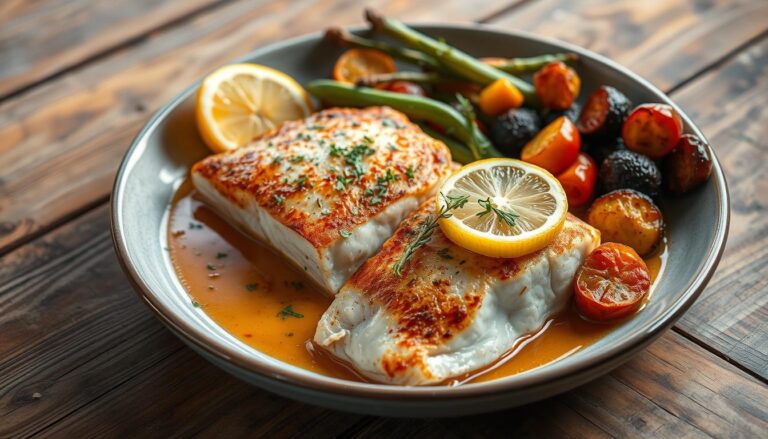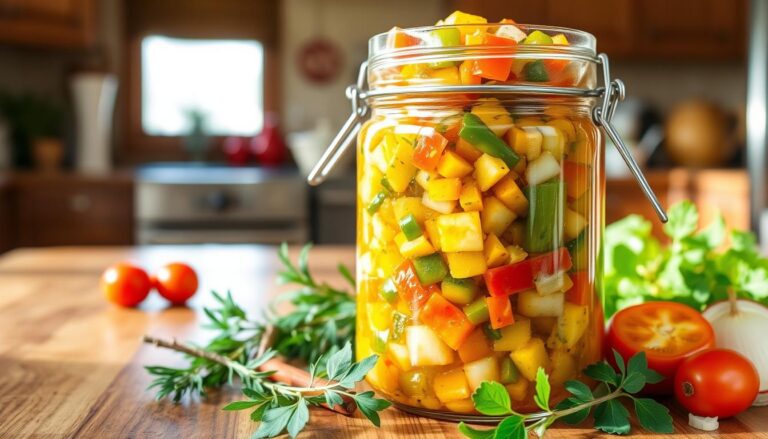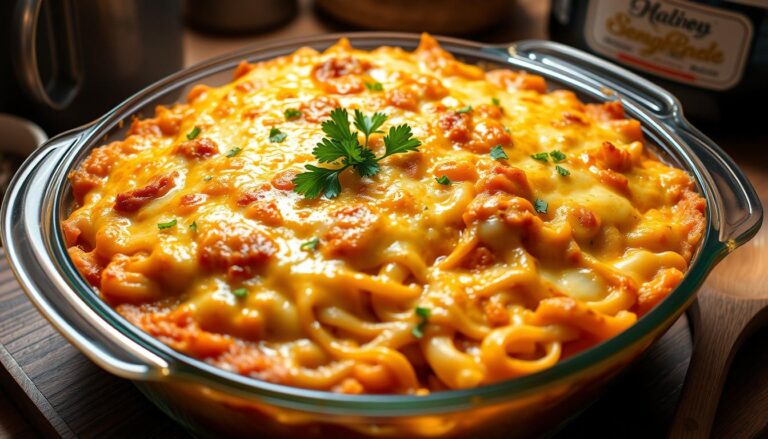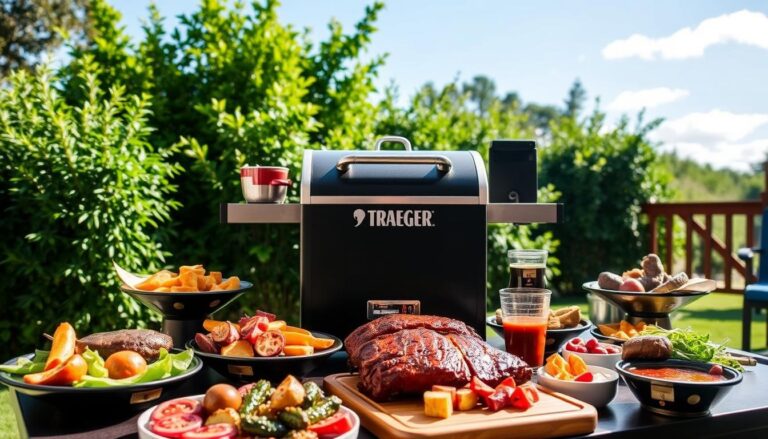Easy Gluten Free Pasta Recipe You Can Make at Home
Gluten Free Pasta Recipe, In today’s world, more people are looking for gluten-free options. If you or someone you love has celiac disease or gluten intolerance, it can be tough to give up pasta. But, with this simple gluten-free pasta recipe, you can still enjoy your favorite pasta dishes.
Making your own gluten-free pasta is not only healthier but also lets you tailor the recipe to your taste. Whether you’re craving classic spaghetti or want to try new shapes and flavors, this guide will help. You’ll learn how to make delicious wheat-free pasta at home.
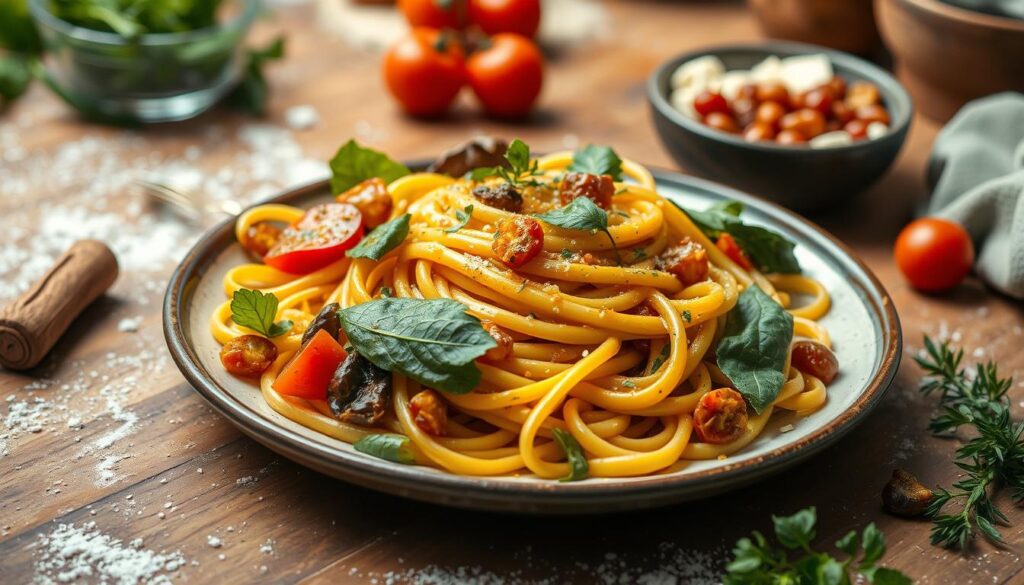
Key Takeaways
- Discover the simplicity of making gluten-free pasta at home
- Explore the health benefits of a gluten-free diet for those with celiac disease or gluten intolerance
- Learn how to create your own customized wheat-free pasta dishes with ease
- Gain the satisfaction of preparing homemade pasta from scratch
- Enjoy the versatility of gluten-free pasta in a variety of classic and modern recipes
Understanding Gluten-Free Pasta Basics
Starting a gluten-free diet doesn’t mean giving up pasta. Today, there are many tasty and healthy gluten-free noodle options. Let’s explore the basics of gluten-free pasta and what you need to make great meals at home.
Common Gluten-Free Flour Types
Choosing the right flours is key for gluten-free pasta. Here are some popular ones:
- Rice flour: It’s versatile and mild, making it a great choice.
- Corn flour: It adds a sweet taste and works well in many recipes.
- Almond flour: It has a nutty flavor and makes pasta tender and delicate.
Trying different flour mixes can help you find the perfect taste and texture for your gluten-free noodles.
Essential Kitchen Equipment
To make your own gluten-free pasta, you’ll need some basic tools:
- Pasta machine or rolling pin: These help roll and shape the dough into thin sheets.
- Mixing bowls: You’ll need sturdy bowls to mix your flour, eggs, and other ingredients.
- Drying rack or flat surface: This is where you let your pasta dry and firm up before cooking.
With the right tools, you can make delicious gluten-free noodles at home.
Key Ingredients Overview
Choosing the right ingredients is important for gluten-free pasta:
- Xanthan gum: It helps the dough stick together, giving it a better texture.
- Eggs: Eggs add structure and richness to the pasta.
- Water or other liquids: Hydrating the dough is crucial for the right consistency.
Getting the right balance of these ingredients will make your gluten-free noodles taste and feel great.
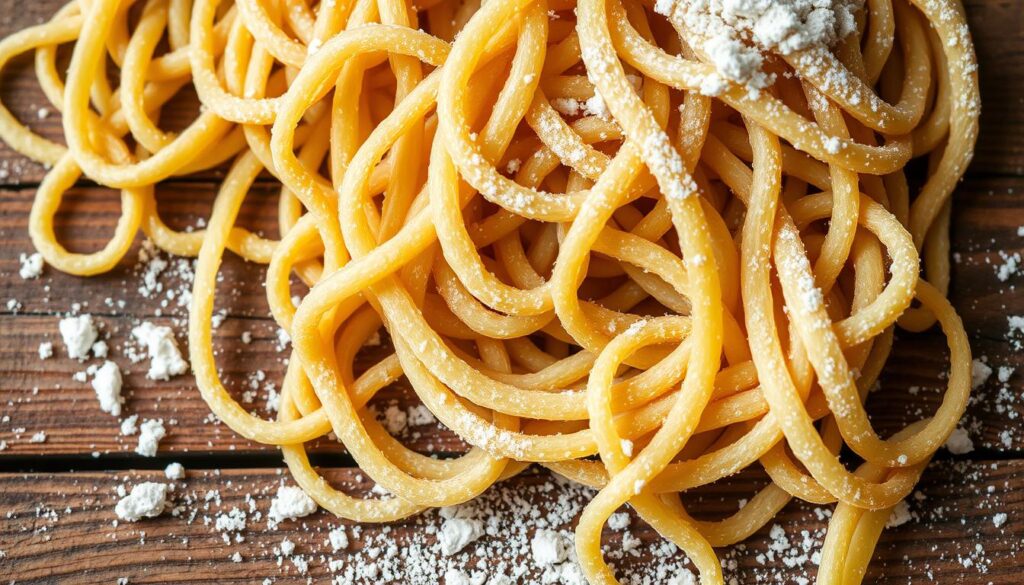
Benefits of Making Your Own Gluten-Free Pasta
If you’re on a gluten-free diet or want to eat more gluten intolerance meals, making your own healthy Italian cuisine is a great idea. It’s cheaper and lets you choose your flavors. These benefits make it a smart choice.
One big plus of making your own pasta is controlling what goes into it. You can pick the best gluten-free flours and other ingredients. This way, your pasta is safe and tastes just right for you.
| Benefit | Description |
|---|---|
| Cost-Effectiveness | Homemade gluten-free pasta is often cheaper than store-bought. Buying ingredients in bulk helps save money. |
| Personalized Flavors | With homemade pasta, you can add herbs, spices, or vegetable purees. This lets you create unique and tasty dishes. |
| Dietary Control | Making your own pasta means you can choose ingredients that fit your diet. This ensures your meals are safe and satisfying. |
Looking to save money, try new recipes, or stick to a gluten intolerance meals diet? Homemade gluten-free pasta is the way to go. It’s rewarding to make healthy Italian cuisine that meets your needs and tastes.
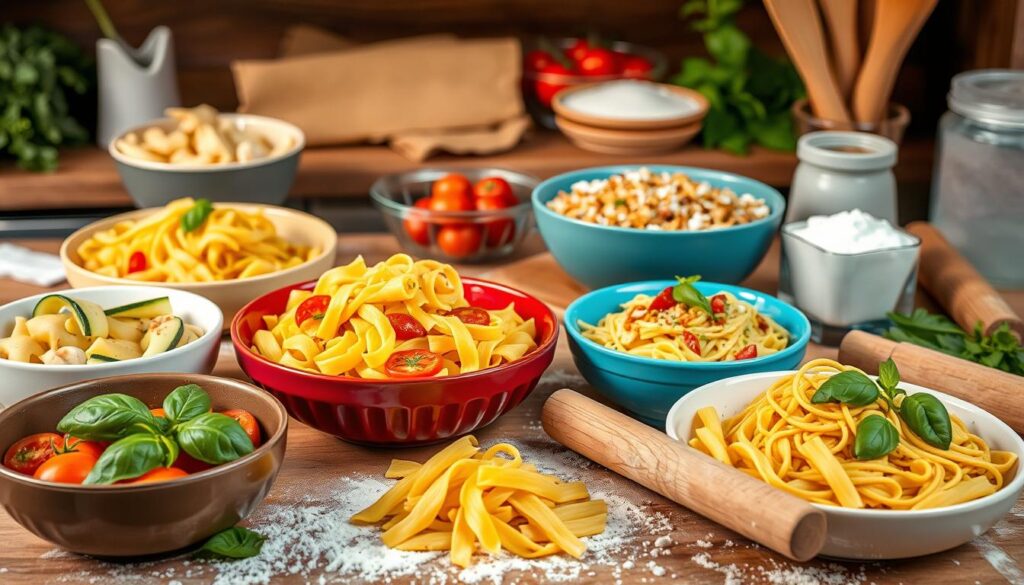
“Homemade gluten-free pasta lets me enjoy Italian flavors without worrying about my diet. It’s a total game-changer for my healthy Italian cuisine.”
Perfect Gluten Free Pasta Recipe for Beginners
Making gluten-free pasta at home is simpler than you might think. With the right ingredients and a few easy steps, you can make a tasty pasta dish. This recipe will help you enjoy homemade gluten-free pasta quickly.
Base Ingredients List
- 2 cups gluten-free all-purpose flour (or a blend of gluten-free flours like rice, tapioca, and potato starch)
- 3 large eggs
- 1 teaspoon salt
- 1 tablespoon olive oil
- 2-3 tablespoons water (as needed)
Step-by-Step Mixing Instructions
In a large mixing bowl, mix together the gluten-free flour, salt, and olive oil. Make a well in the center and crack the eggs into it. Use a fork to mix the eggs into the flour, adding water as needed to make a smooth dough.
Kneading and Resting Tips
After the dough comes together, knead it on a lightly floured surface for about 5 minutes. It should become smooth and elastic. Then, cover it with a towel or plastic wrap and let it rest for at least 30 minutes. This step helps the flours hydrate, making the pasta better.
Follow these steps to make a delicious batch of homemade gluten free pasta recipe. It will impress your friends and family. Start exploring celiac diet recipes and enjoy making your own pasta from scratch.
Best Flour Combinations for Texture and Taste
Creating delicious gluten-free pasta is all about the right flour mix. By mixing different grain-free and high-protein flours, you get pasta that’s both tasty and has great texture. Let’s look at some top choices to make your homemade pasta stand out.
For silky pasta, try adding quinoa flour or chickpea flour to your mix. These flours not only feel great but are also full of nutrients. Quinoa flour, for example, has a nutty flavor that goes well with many sauces.
Even on a grain-free diet, you can still make tasty pasta. Almond flour and coconut flour are great for making pasta that’s both tender and strong. Play with the amounts to get the taste and texture just right.
| Flour Type | Texture | Flavor |
|---|---|---|
| Quinoa Flour | Silky Smooth | Nutty |
| Chickpea Flour | Creamy | Earthy |
| Almond Flour | Tender | Subtly Sweet |
| Coconut Flour | Sturdy | Tropical |
Creating the perfect gluten-free pasta is all about trying new things. Don’t hesitate to mix different flours until you find the perfect match. Enjoy the process and the yummy results!
Rolling and Shaping Your Pasta
Making gluten-free noodles at home is a fun and rewarding task. Learning to roll and shape your pasta is crucial. You can use traditional hand-rolling or a pasta machine for ease.
Hand Rolling Techniques
Begin by dusting your work area with gluten-free flour, like rice or tapioca. Split your dough into smaller pieces. Then, use a rolling pin to roll each piece into thin sheets.
Be patient and gentle, as gluten-free dough is more delicate than regular dough.
Using a Pasta Machine
Using a pasta machine makes things easier. Feed your dough through the rollers, adjusting the thickness as needed. Lightly dust the dough with flour to prevent sticking.
Keep in mind the gluten-free pasta’s unique texture as you shape it.
Popular Pasta Shapes Guide
- Fettuccine: Cut the rolled dough into long, thin strips for classic fettuccine.
- Penne: Use a knife or pizza cutter to slice the dough into short, cylindrical tubes.
- Ravioli: Cut the dough into squares or rounds, then fill with your favorite gluten-free fillings.
Try different shapes to make your gluten-free pasta dishes more interesting. It’s a great way to show off your cooking skills.
Success with gluten-free pasta comes from patience and a gentle touch. With practice, you’ll soon be making your own delicious wheat-free pasta dishes.
Cooking Your Fresh Gluten-Free Pasta
Making your own gluten-free pasta is a fun process. It needs some care and attention. By using the right cooking methods, you can make your meals tasty and safe for those with gluten intolerance.
To cook your pasta right, start by boiling a big pot of salted water. Use a lot of water, about 4-6 quarts for each pound of pasta. This helps prevent the noodles from sticking together. Once boiling, add your pasta gently and stir to cook evenly.
Gluten-free pasta cooks faster than regular pasta. So, watch the time closely. Aim for an al dente texture, which takes about 2-4 minutes. If it cooks too long, it will become mushy. So, taste it often as it cooks.
To check if it’s done, use a fork or tongs to lift a strand. It should be tender but still have a bit of bite. When it’s right, drain it quickly and rinse with cool water to stop cooking.
| Pasta Type | Cooking Time | Water-to-Pasta Ratio |
|---|---|---|
| Gluten-Free Spaghetti | 2-4 minutes | 4-6 quarts per 1 lb of pasta |
| Gluten-Free Fettuccine | 3-5 minutes | 4-6 quarts per 1 lb of pasta |
| Gluten-Free Penne | 4-6 minutes | 4-6 quarts per 1 lb of pasta |
The cooking times and water ratios can change based on your gluten-free flour and pasta thickness. Always watch your pasta closely. Adjust the cooking time to get the perfect texture for your gluten-free meals.
Storage and Preservation Methods
Storing your gluten-free pasta right is key to keeping it fresh. Whether you’ve made a batch of gluten free pasta recipe or enjoyed some tasty wheat-free pasta dishes, these tips will help. They ensure your pasta stays fresh and ready to eat.
Freezing Instructions
Freezing is a great way to store pasta for longer. Let your pasta dry completely first. Then, put it in an airtight container or bag that’s safe for the freezer.
Make sure to squeeze out any air before sealing. This prevents freezer burn. Gluten-free pasta can be frozen for up to 3 months, keeping its taste and texture.
Shelf Life Guidelines
Fresh, uncooked gluten-free pasta doesn’t last as long as wheat pasta. It’s best to use it within 3-5 days when stored in the fridge. This ensures it stays fresh and safe to eat.
Dried gluten-free pasta, however, can last 6-12 months in the pantry. Keep it in an airtight container in a cool, dry spot. This helps it keep its texture and taste.
| Pasta Type | Refrigerator | Freezer | Pantry |
|---|---|---|---|
| Fresh Gluten-Free Pasta | 3-5 days | Up to 3 months | N/A |
| Dried Gluten-Free Pasta | N/A | N/A | 6-12 months |
By following these tips, you can enjoy your homemade gluten free pasta recipe or wheat-free pasta dishes for a long time. They’ll stay fresh and full of flavor with every bite.
Troubleshooting Common Issues
Making gluten-free noodles at home can be rewarding but comes with challenges. Issues like crumbly dough or pasta falling apart are common. We’ll help you solve these problems to get great results with your gluten-free pasta.
Tackling Crumbly Dough
Crumbly dough is a common problem when making gluten-free noodles. It often happens when the flour-to-liquid ratio is wrong or the dough isn’t kneaded enough. To fix it, add a little more water or egg until the dough is smooth and pliable. Knead the dough well to help the flours bind together.
Preventing Pasta Breakage
Pasta falling apart during cooking is another common issue. It can be due to not resting the dough long enough or using the wrong flour blend. To prevent this, let your dough rest for at least 30 minutes before rolling and cutting. Also, try different flour combinations to find the right texture and strength.
| Common Issue | Possible Cause | Solution |
|---|---|---|
| Crumbly Dough | Incorrect flour-to-liquid ratio, insufficient kneading | Add more water or egg, knead dough thoroughly |
| Pasta Breakage | Inadequate resting time, unsuitable flour blend | Allow dough to rest, experiment with different flour combinations |
Every kitchen and ingredient mix is unique. So, don’t hesitate to experiment and find the best recipe for your gluten-free pasta. With a little troubleshooting and trial and error, you’ll soon be making professional-quality gluten-free noodles.
Sauce Pairings and Serving Suggestions
Finding the right sauce for your gluten-free pasta can make a big difference. Whether you love classic Italian flavors or modern twists, there’s something for everyone. These options are not only delicious but also fit your dietary needs.
Classic Italian Sauces
For a taste of Italy, try these classic sauces with your gluten-free pasta:
- Marinara: A simple yet flavorful tomato-based sauce that complements a wide variety of pasta shapes.
- Pesto: Vibrant and fragrant, pesto made with fresh basil, pine nuts, and Parmesan cheese is a perfect match for gluten-free pastas.
- Alfredo: Rich, creamy, and indulgent, an alfredo sauce is a crowd-pleasing option for those seeking a comforting, healthy Italian cuisine.
Modern Fusion Options
For a fresh take on gluten-free pasta, try these modern sauce ideas:
- Lemon-Garlic Shrimp: A light, zesty sauce that pairs beautifully with gluten-free pasta shapes, adding a touch of Mediterranean flair.
- Roasted Vegetable Ragu: A nutrient-dense sauce made with a variety of roasted vegetables, perfect for those with gluten intolerance meals.
- Creamy Mushroom Stroganoff: A rich, comforting sauce that combines the earthiness of mushrooms with a velvety texture, complementing gluten-free pasta perfectly.
Experimenting with different sauces can help you find the perfect flavor. This way, you can enjoy a satisfying and healthy Italian meal, even with gluten-free pasta.
| Sauce | Pasta Shape | Dietary Consideration |
|---|---|---|
| Marinara | Spaghetti, Penne | Gluten-free, Vegetarian |
| Pesto | Fusilli, Linguine | Gluten-free, Vegetarian |
| Alfredo | Fettuccine, Rigatoni | Gluten-free |
| Lemon-Garlic Shrimp | Linguine, Angel Hair | Gluten-free |
| Roasted Vegetable Ragu | Penne, Farfalle | Gluten-free, Vegetarian |
| Creamy Mushroom Stroganoff | Egg Noodles, Tagliatelle | Gluten-free |
Conclusion
Making gluten-free pasta at home is fun and easy. You can mix different flours and shapes to make pasta that’s just as good as the traditional kind. It’s great for those who need to avoid gluten or just want healthier food.
Success comes from knowing how gluten-free flours work and keeping an eye on your dough. With a little practice, you’ll make pasta that’s just right. It’s a great way to enjoy tasty, healthy meals.
So, go ahead and try making gluten-free pasta. Enjoy the feeling of eating a meal that’s good for you and tastes amazing. Bon appétit!
FAQ
What are the main types of gluten-free flours used for pasta making?
For pasta making, you can use rice flour, corn flour, almond flour, and chickpea flour. These flours can be mixed in different ways to get the right texture and taste.
What kitchen equipment is essential for making gluten-free pasta at home?
You’ll need a pasta machine or rolling pin, a dough cutter or knife, and a big pot for boiling. A stand mixer and pasta drying rack can also be helpful.
What are the key ingredients in a gluten-free pasta recipe?
Gluten-free pasta recipes need gluten-free flour, eggs, water, and sometimes xanthan gum. The exact mix depends on the recipe and the texture you want.
What are the benefits of making your own gluten-free pasta at home?
Making your own pasta at home saves money and lets you choose the flavors. It’s also healthier because you avoid additives found in store-bought pasta.
What is the best flour combination for a beginner-friendly gluten-free pasta recipe?
Beginners should try a mix of rice flour and cornstarch. This combo makes a smooth pasta that’s easy to work with.
How do I properly knead and rest the gluten-free pasta dough?
Knead the dough for a few minutes, pushing and folding it with your hand. This makes the dough smooth and elastic. Let it rest for at least 30 minutes before shaping.
What are some popular gluten-free pasta shapes I can make at home?
You can make fettuccine, penne, ravioli, and linguine at home. With a pasta machine or by hand, you can shape the dough into many forms.
How do I cook fresh gluten-free pasta to achieve the perfect texture?
Boil a large pot of salted water. Cook the pasta for 2-3 minutes, until it’s al dente. Don’t overcook, as gluten-free pasta gets mushy.
How can I store and preserve my homemade gluten-free pasta?
Store fresh pasta in the fridge for up to 5 days. Freeze it for up to 3 months. Cook frozen pasta straight from the freezer.
What are some common issues I might encounter when making gluten-free pasta and how can I troubleshoot them?
Issues like crumbling dough or pasta falling apart can happen. Use the right flour blend, knead well, and don’t overcook to fix these problems.
What types of sauces and serving suggestions pair well with homemade gluten-free pasta?
Gluten-free pasta goes well with many sauces, like marinara and pesto. Try it with grilled meats, vegetables, and herbs for a tasty meal.


